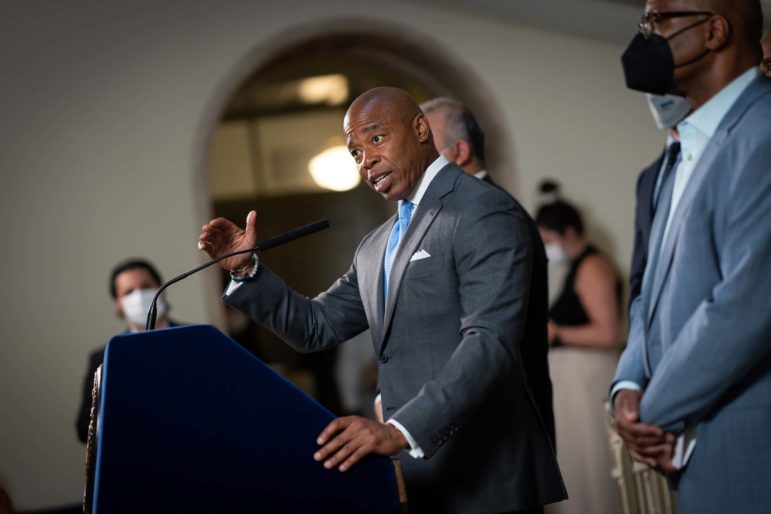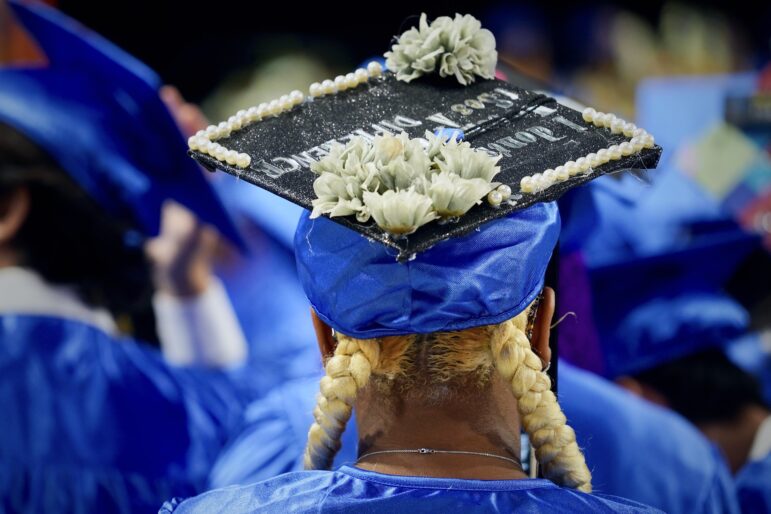The declaration will allow the the city to open a new intake facility specifically for asylum-seekers and immigrants who have made their way to homeless shelters. It will also allow DHS to issue contracts to nonprofits to open additional shelters, most likely in hotels, while bypassing public review and the usual competitive bidding process.

Ed Reed/Mayoral Photography Office.
NYC Mayor Eric Adams at a homelessness-related press conference on July 21, 2022.An emergency declaration announced Monday by Mayor Eric Adams will make it easier for city agencies to open new homeless shelters as a rising number of entrants, including asylum-seekers in need of services, strain current capacity.
The declaration, approved by Comptroller Brad Lander, will allow the city to tap a nonprofit to open a new intake facility specifically for asylum-seekers and immigrants who have made their way to New York City shelters after recently arriving in the United States. Adams’ order will also allow the Department of Homeless Services (DHS) to issue contracts to nonprofits to open additional shelters, most likely in hotels, while bypassing public review and the usual competitive bidding process.
READ MORE: Who Are The Families Entering NYC Shelters From the Southern Border?
The number of people in the shelter system has risen by about 5,200 since January, with Adams pinning a recent spike on an “unprecedented surge” in asylum-seekers and other immigrants—a narrative challenged by some homeless advocates. Adams said Monday that more than 4,000 recently arrived immigrants have sought shelter services since May in addition to another roughly 100 people per night. A DHS spokesperson later clarified that the mayor was referring to 100 asylum-seekers per night. At the same time, the shelter system has seen a customary summer surge likely worsened by record-high rents and administrative hurdles to permanent housing for homeless New Yorkers.
“We can no longer wait—and this declaration will allow the city to procure sorely needed additional resources as quickly as possible,” Adams said in a statement Monday.
New York City is under two unique court orders to provide shelter to all single adults who ask for it, and to every family who visits a Bronx intake facility, while officials investigate whether they have other housing options. With the city pressed for shelter space, at least four immigrant families stayed overnight at the intake center last month in violation of local law. In the hours before a news report on those illegal overnight stays was published, Adams issued a statement attributing the rise in the shelter population to newly arrived immigrants.
Historically, only a fraction of the city’s shelter population has come from outside New York City, past records obtained by City Limits show. DHS does not ask for a person’s residency status at intake, but officials said they based their estimate of 4,000 recently-arrived immigrants who’ve visited the intake facility in recent months on interviews with clients, as well as assumptions based on an imprecise review of benefit and entitlement status (only citizens and legal permanent residents can qualify for federal assistance programs like food stamps, for example). Not every person who visits intake ultimately enters the shelter system.
In a letter to Lander and the city’s corporate counsel, Sylvia Hinds-Radix, Department of Social Services Commissioner Gary Jenkins said the “Referral Center” and the new shelters planned under Monday’s emergency declaration “will provide targeted supports to these arriving families and individuals that go beyond standard support structures and programming.”
The city has not yet picked a provider to run the Referral Center, which will make connections with other nonprofits, legal assistance groups and government programs based on clients’ needs, Jenkins stated in his letter. A DHS spokesperson said the Mayor’s Office of Immigrant Affairs will identify an organization to run the facility.
The declaration allows the city to issue contracts to a list of pre-qualified nonprofits that will provide services in commercial hotels leased as shelters. Lander in a statement pledged to expedite those contracts. Already, the city has resumed renting hotels for shelter space—including asylum-seekers and other recently-arrived immigrants—after ending the use of commercial lodgings for homeless families last year.
A day before the mayor announced the declaration, the number of people in DHS shelters for single adults, adult families and families with children topped 50,000 for the first time in over a year. More than 62,000 different people stayed in a shelter run by DHS or another city agency in June, according to the most recent public data tracked by City Limits.
Since June, shelter staff and administrators have described an increase in the number of recently-arrived immigrants entering their shelters. City Limits and other news outlets have also talked with various immigrants from South America who made their way to DHS’ family intake center after being referred by nonprofit organizations near the Southern Border. Other immigrants who recently moved into shelters said they had established addresses in the U.S. before becoming homeless.
Outside one Manhattan hotel where several families who recently arrived from Venezuela had been placed last month, one woman described how she had moved to Queens from Peru two and a half years ago and became homeless after her landlord harassed and assaulted her. She said she visited the Bronx family intake shelter in early July and was assigned a room in the hotel with her two children.
“There are people here who just crossed the border, there are Americans and then there are people like me who have been here,” said the woman, who asked not to use her name in a story.
Still others, like seven families from Venezuela interviewed by City Limits, said they had traveled through Central America and Mexico by foot before crossing the border in Texas and Arizona. There, nonprofit organizations purchased flights to New York for them. One mother said her family learned about the city’s homeless shelters from other immigrants also heading to New York after arriving in Texas.
In his letter, Jenkins told Lander and Hinds-Radix that DHS tries to predict shelter space needs down the road, but “the asylum-seeking population that has arrived in the past few months was not anticipated when determining capacity needs.”
Adams has said he will seek reimbursement from the federal government for housing asylum-seekers, a process that could be made easier by grouping recently arrived immigrants in specific locations like new shelters. The Federal Emergency Management Administration and Department of Homeland Security did not respond to emails seeking information on potential reimbursements.
Even before city officials began to cite the rising number of migrants entering city facilities, they faced scrutiny for not adding more shelter space as the homeless population began to tick up, and lengths of stay for families increased. Last month, DHS had just a 1 percent vacancy rate in its family shelter system, according to the Legal Aid Society, which monitors shelters and homeless services policy under court order. The agency is supposed to have at least a 3 percent vacancy rate.
“The city has a serious problem in that their shelter capacity, particularly for families with children, is extremely tight right now and if they can’t add shelter units they’re not going to be able to meet their legal obligations,” Legal Attorney supervising attorney Josh Goldfein said last month.
On Monday, Legal Aid and the Coalition for the Homeless said they welcomed the emergency declaration but wanted more information about the new facilities and access to inspect conditions. The Coalition has a legal mandate to inspect facilities under a court order that established a right to shelter in New York City.
“The devil is in the details,” the two groups said in a joint statement. “We call on Mayor Adams to release specifics around his plan to rapidly procure additional shelter beds and resources for incoming asylum seekers.”
A combination of skyrocketing rents, limited available housing and the end of state eviction protections threatens to drive more people into homelessness, but DHS said that has not yet contributed significantly to the rising shelter population. The number of eviction cases in city courts has increased every month so far this year, after a pandemic-related moratorium ended in January.
On a January conference call with service providers and advocates, Jenkins fielded questions about the end of state eviction protections and said DHS was “not anticipating folks to be evicted and to become homeless” because of state rent relief programs, as well as access to attorneys through the city’s right-to-counsel program.
More than six months later, a DHS spokesperson told City Limits on July 25 that the system has not seen a major impact from the end of the so-called eviction moratorium. Just 1 percent of people entering the shelter system became homeless as a result of an eviction, compared to about 10 percent prior to the pandemic, they said.
The emergency declaration will result in less oversight of shelter and service contracts, but Queens Councilmember Julie Won, chair of the contracts committee, said the decision seemed necessary to meet the immediate need.
A nonprofit recently leased lodgings in Long Island City, within her district, to place families, she said, adding that she hoped the providers tapped to run the shelters across the city will offer holistic services.
“The emergency procurement declaration today from the mayor is something that is going to hopefully allow the asylum-seekers to have dignified temporary housing as well as resources so they can find their way in this country,” she said.
Won said she will consider holding an oversight hearing down the road to uncover more information about the emergency contracts as well as services at the Referral Center and new shelters.
“I will make sure that as contracts chair I’m going to continue to have oversight to ensure those that are contracted to do this work are doing it properly,” she said.
Catherine Trapani, director of Homeless Services United, which represents providers, said the declaration should also come with more comprehensive planning among city agencies, particularly the Department of Education. Schools located near the new shelters will see an increase in English-Language Learners who require additional educational and social services, she said.
But in the short-term, the emergency order will enable DHS to add more needed beds.
“You need to be able to open capacity quickly,” she said.









4 thoughts on “Mayor’s Emergency Declaration Will Speed Shelter Openings as Homeless Population Rises ”
Although the City is obligated to provide “shelter” to those in need, families in which the parents are not citizens or legal residents cannot qualify for subsidized housing.
Thus they could be residing in NYC “shelter” housing (hotels in this case) indefinitely – yes?
That is correct!
Won stated that in order to learn more about the emergency contracts, as well as the services at the Referral Center and new shelters, she may call an oversight hearing in the future.
This is a great decision by the government for the homeless people.